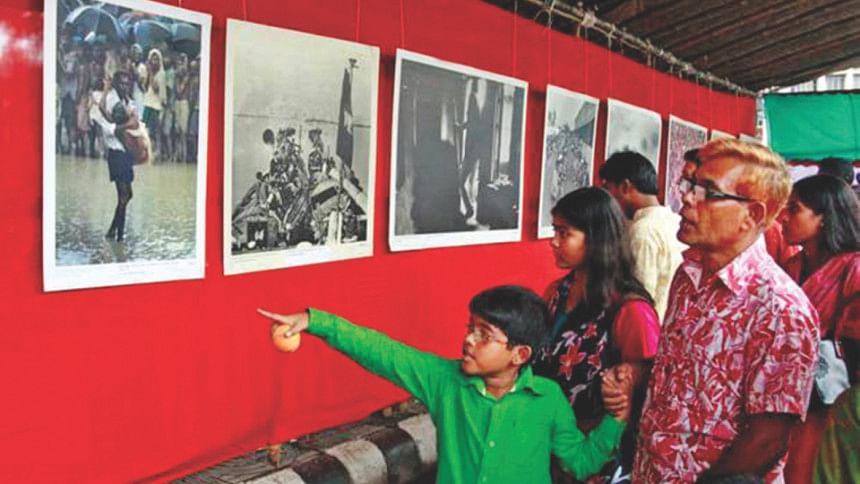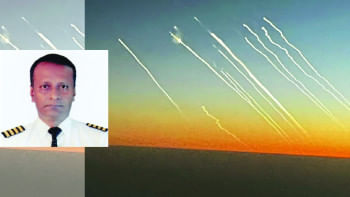From the archives: Tariq Ali's reflections on Muktijuddho Jadughar

When one looks at the magnificent edifice that stands out amidst the other buildings at Agargaon, one cannot but feel a sense of awe by the image of strength, determination and rebellion--hallmarks of the Bengali character--which the building is able to convey. After the assassinations in 1975 the Trustees agonizingly watched as the greatest moment in the history of the Bangali nation was being buried under the wave of international and national intrigues whose ultimate aim was to undo what the Bangalis had done in 1971, and thus bring back the equation in South Asia to an equilibrium with which they were comfortable. The West wanted the technology-rich Pakistan war machine (well stocked by the West) to contain a technology starved Indian army, demoralised by the 1962 debacle on their northern borders and make Pakistan the bastion of western dominance in this part of the world.
It is almost a freak of episode of history that Bangladesh was able to achieve what no Biafra, Sri Lanka or Mindanao was able to do, despite long drawn out wars being fought there for self rule. That Pakistan would ultimately capitulate had become clear when the World Bank visit in June 1971 concluded that its foreign exchange reserves had dropped to a flimsy 137 million dollars, whereas it owed more than that to the lending agencies. In other words, Pakistan was already a bankrupt nation. On the diplomatic front however, Mrs. Gandhi was hitting one unsympathetic wall after another and the diplomatic efforts of India were almost drowned in the hall of the United Nations when the Polish resolution, the last nail in Bangladesh's coffin, was tabled for voting. It was the 3 consecutive vetoes which the Soviet Union cast that bought enough time for General Nagra to be able to send his famous note to Niazi from across the Turag River at Mirpur on December 15.
The objective of the Trustees of the museum has been that the ordinary citizen should take ownership of the museum. The citizens have done that, most emphatically. The museum has proved once again that Bengalis can be extremely generous when it comes to a good cause. The Trustees sensed that the ordinary citizen was proudly taking ownership of the museum from the day it began its journey, from the way they started referring to the small 2000 sq. ft. building in Segun Bagicha as "our museum" and then when the new building was being built in Agargaon, in the way ordinary people donated (there is a school-girl in Brahmanbaria who gave us three and a half Takas from her tiffin money), to the building fund. Today the museum is not far from its avowed goal that more than half of the funding of this 102 crore building should be generated through the participation of the citizens. The government, on the other hand, has been outstandingly supportive, and despite being ordinary citizens, the Trustees are humbled by the love and respect that they get from the ordinary citizen, the news-media and the government. This is remarkable in a country which for the last three centuries have been reared in the dictum that the "shodashoi sarkar" was omnipotent and the lives of the common man was meant only to serve that "sarkar".
The political objective of the various regimes after 1975 was certainly non-friendly to the struggle that the Bangali nation had waged in 1971. Although one is certain that eventually a museum dedicated to our Muktijuddho, would have been built, that museum would have been interpreted in how the government of that time viewed our Muktijuddho and its history would certainly have been told in a manner that reflected the domestic and international politics of that period. One need not have any doubts that had a museum been established under the aegis of those regimes, the magnificent story of our War of Liberation would have been woven with a different thread and would have borne the stamp of the government in power at the time. It is from this apprehension that the Trustees felt the urgency to create a museum that would preserve the glorious history of the Bangali nation's struggle before it was completely obliterated from the memory of its citizens. The Trustees are sanguine in the belief that they have not been swayed by party loyalties and the museum truly captures the spirit of the people and the way in which the exiled government, despite its many hiccups conducted the war.
We may not instantaneously realise it, but Bangalis began to feel as far back in September 1947, that they were strangers in this new land of Pakistan, an un-natural nation hewn out of the trunks of a tree whose roots were supposed to be embedded in a common religion. It refused to recognise that the tree needed to be watered by norms that are set by social and cultural traditions and the lifestyle of the population. The politically illiterate nawabs, khwajas and the civil and army bureaucracy who dominated Pakistan's politics committed one blunder after another and very quickly were able to alienate the Bangalis beyond their point of return. But this turnaround should not come as a surprise because the Bangali character has always been a strange amalgam of confusion, near anarchy and a dogged adherence to independent thought and democratic values.
It was from one such democratic exercise after the period of matsannay that the people chose a leader-Gopal-from amongst themselves and the Pal Dynasty was born. It is also not surprising that three centuries later the descendant of Gopal was deposed in another uprising spearheaded by Dibbak, a leader of the Koibarta fishermen, creating an independent but short-lived rule and paving the way for the ultimate demise of the Pal Dynasty. This dichotomy which has dogged the Bangali mindset is again its greatest strength. The British, who on countless occasions have dealt with peoples' uprisings in Bengal, lost no time in branding them as a non-martial nation to curtail their employment in their military forces. This is the legacy that Bangladesh had carried until 1971. Our Muktijuddho changed all that.
Apart from exhibiting the story of our war, the Liberation War Museum is an activity oriented museum. It celebrates various international and national events--in fact as many as 19 of them--including two events which last 7 days each in March and December. However, its greatest success has been its school programme, where children from the Dhaka Metropolitan Area are bussed-in to visit the museum and where we send out a small version of the museum in two buses, which has visited at least one school in every upazila of 61 districts of the country. We have thus been able to reach out to almost 1.2 million students, in the remotest villages. Apart from showing the museum artefacts and a film on the war, there are two other innovative exhibitions, one informing them about Human Rights and the other about developing an inclusive frame of mind in the global village of tomorrow and learn to tolerate to the otherness of other people. However, the most successful part of the school programme is that we have been able to create an archive of more than 28,000 pieces of writing, where students interview their near ones, who have actually witnessed or participated in the war and these students then put their interview down on paper. All these writings are preserved and have enabled the museum to amass one of the world's largest repositories of oral history.
The museum is conducting research on Genocide in its Centre for Genocide Studies. It is also conducting research work at another Centre for Liberation War Studies. These Centres have been allocated adequate space and resources in the new building and one hopes will one day become world class institutions.
The museum has played a very important role in the trial of those charged with crimes against humanity by the International Crimes Tribunal, 1973 by providing documents related to the war. It also helped build public opinion in favour of the trials during the last 5 years by holding many seminars on trials regarding crimes against humanity and the experiences of other similar courts on genocide, in which many noted international scholars have participated. One of the employees has also testified in the trials. As we move into this magnificent building, 90 times the size of the present building, hopefully next March, the Trustees feel satisfied that they have done their bit for the Bengali nation.
The writer is Social Activist and Trustee, Liberation War Museaum.





Comments